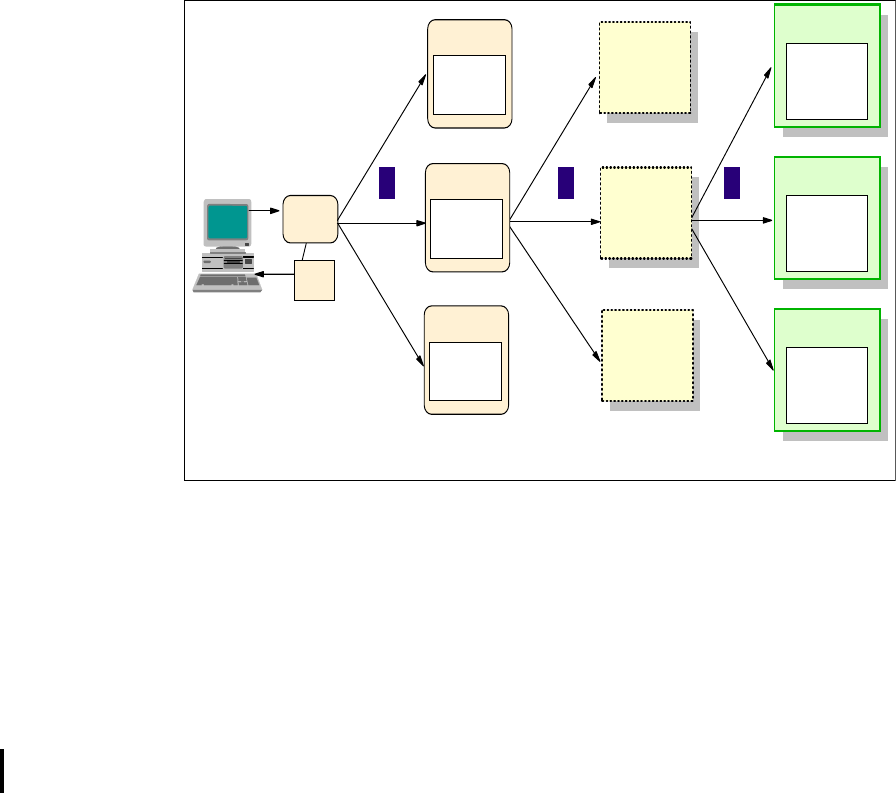444 Patterns: Implementing Self-Service in an SOA Environment
If the connection timeout is set to a very small number such as 1, the
ResourceAllocationException is thrown almost immediately after the pool
manager determines that the maximum number of connections has been
used. If the connection timeout is set to 0, the pool manager waits until a
connection can be allocated. In other words, it waits until the number of
connections falls below the maximum connections.
Maximum connections
This is the maximum number of managed connections that can be created by
a particular ManagedConnectionFactory. After this number is reached, no
new connections are created, and either the requester waits or the
ResourceAllocationException is thrown. If maximum connections is set to 0,
the number of connections can grow indefinitely. Maximum connections must
be larger than minimum connections.
Minimum connections
The minimum number of managed connections to maintain. If this number is
reached, the garbage collector will not discard any managed connections.
Note that if the actual number of connections is lower than the value specified
by the minimum connections settings, no attempt will be made to increase the
number of connections to the minimum. Minimum connections must be less
than or equal to maximum connections.
Reap time
This is the number of seconds between runs of the garbage collector. The
garbage collector discards all connections that have been unused for the
value specified by the unused timeout.
To disable the garbage collector, set the reap time to 0. Another way to
disable the garbage collector is to set the unused timeout to 0.
Unused timeout
Number of milliseconds after which an unused connection is discarded.
Setting this value to 0 disables the garbage collector.
12.6.3 Scalability and availability considerations
As shown in Figure 12-33 on page 445, there are several scalability and
availability options when using J2EE connectors to access CICS enterprise
applications:
EJB workload management provided by WebSphere Application Server.
Inbound CICS TG requests (TCP or HTTP) can be workload managed using
various methods.

Chapter 12. J2EE Connector Architecture scenario 445
CICS requests (ECI or EPI) can be workload managed using CICS scalability
technologies.
Figure 12-33 Scalability options
EJB workload management
EJBs deployed in WebSphere Application Server V6 can take advantage of the
workload management (WLM) facility for EJBs. In WebSphere Application
Server, workload management for EJBs is enabled automatically when clusters
are created in a cell. There is no need for a special configuration to enable it.
Workload management of CICS TG requests
This section describes scalability and availability options between EJBs in a
distributed environment (Windows or UNIX) and the CICS TG in a zSeries®
environment. An ECI request from a J2EE connector resource adapter goes to
the CICS TG on zSeries as an HTTP or TCP request.
Web
Browser
Servl et
CICS ECI
Resource
Adapter
EJB
CICS ECI
Resource
Adapter
EJB
CICS ECI
Resource
Adapter
EJB
:
CI CS
Transaction
Gat ewa y
CICS
Transaction
Gat eway
CICS
Transaction
Gat eway
:
CICS TS
CI CS
Progr am
(ITSOMART)
CICS TS
CI CS
Progr am
(ITSOMART)
CICS TS
CI CS
Progr am
(ITSOMART)
:
RMI/IIOP
TCP/HTTP EXCI/ MRO
1 2 32
JSP
Get Patterns: Implementing Self-Service in an SOA Environment now with the O’Reilly learning platform.
O’Reilly members experience books, live events, courses curated by job role, and more from O’Reilly and nearly 200 top publishers.

